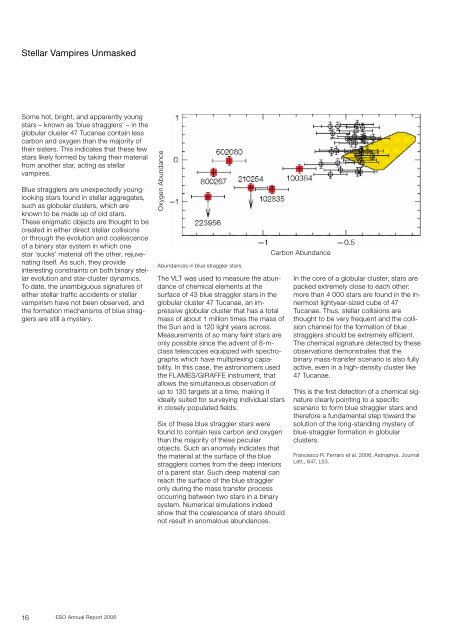Untitled - ESO
Untitled - ESO
Untitled - ESO
You also want an ePaper? Increase the reach of your titles
YUMPU automatically turns print PDFs into web optimized ePapers that Google loves.
Stellar Vampires Unmasked<br />
Some hot, bright, and apparently young<br />
stars – known as ‘blue stragglers’ – in the<br />
globular cluster 47 Tucanae contain less<br />
carbon and oxygen than the majority of<br />
their sisters. This indicates that these few<br />
stars likely formed by taking their material<br />
from another star, acting as stellar<br />
vampires.<br />
Blue stragglers are unexpectedly younglooking<br />
stars found in stellar aggregates,<br />
such as globular clusters, which are<br />
known to be made up of old stars.<br />
These enigmatic objects are thought to be<br />
created in either direct stellar collisions<br />
or through the evolution and coalescence<br />
of a binary star system in which one<br />
star ‘sucks’ material off the other, rejuvenating<br />
itself. As such, they provide<br />
interesting constraints on both binary stellar<br />
evolution and star-cluster dynamics.<br />
To date, the unambiguous signatures of<br />
either stellar traffic accidents or stellar<br />
vampirism have not been observed, and<br />
the formation mechanisms of blue stragglers<br />
are still a mystery.<br />
16<br />
<strong>ESO</strong> Annual Report 006<br />
Oxygen Abundance<br />
Abundances in blue straggler stars.<br />
The VLT was used to measure the abundance<br />
of chemical elements at the<br />
surface of 43 blue straggler stars in the<br />
globular cluster 47 Tucanae, an impressive<br />
globular cluster that has a total<br />
mass of about 1 million times the mass of<br />
the Sun and is 1 0 light years across.<br />
Measurements of so many faint stars are<br />
only possible since the advent of 8-m-<br />
class telescopes equipped with spectrographs<br />
which have multiplexing capability.<br />
In this case, the astronomers used<br />
the FLAMES/GIRAFFE instrument, that<br />
allows the simultaneous observation of<br />
up to 130 targets at a time, making it<br />
ideally suited for surveying individual stars<br />
in closely populated fields.<br />
Six of these blue straggler stars were<br />
found to contain less carbon and oxygen<br />
than the majority of these peculiar<br />
objects. Such an anomaly indicates that<br />
the material at the surface of the blue<br />
stragglers comes from the deep interiors<br />
of a parent star. Such deep material can<br />
reach the surface of the blue straggler<br />
only during the mass transfer process<br />
occurring between two stars in a binary<br />
system. Numerical simulations indeed<br />
show that the coalescence of stars should<br />
not result in anomalous abundances.<br />
Carbon Abundance<br />
In the core of a globular cluster, stars are<br />
packed extremely close to each other:<br />
more than 4 000 stars are found in the innermost<br />
lightyear-sized cube of 47<br />
Tucanae. Thus, stellar collisions are<br />
thought to be very frequent and the collision<br />
channel for the formation of blue<br />
stragglers should be extremely efficient.<br />
The chemical signature detected by these<br />
observations demonstrates that the<br />
binary mass-transfer scenario is also fully<br />
active, even in a high-density cluster like<br />
47 Tucanae.<br />
This is the first detection of a chemical signature<br />
clearly pointing to a specific<br />
scenario to form blue straggler stars and<br />
therefore a fundamental step toward the<br />
solution of the long-standing mystery of<br />
blue-straggler formation in globular<br />
clusters.<br />
Francesco R. Ferraro et al. 006, Astrophys. Journal<br />
Lett., 647, L53.

















